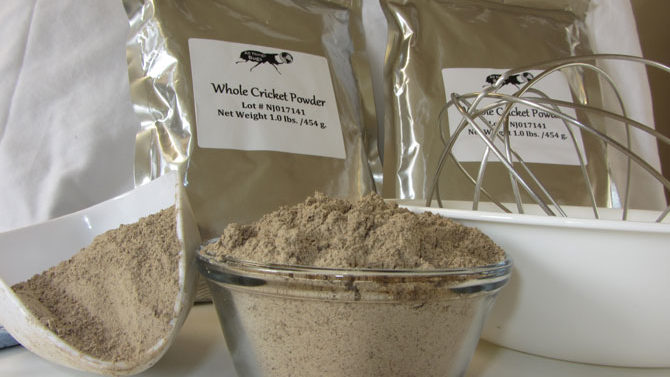Aaron Dossey thinks crickets could provide life-sustaining protein to malnourished children in developing countries. So far, the Gates Foundation and U.S. Department of Agriculture have thought enough of the idea to give him more than half a million dollars to figure it out.
“When I first started taking this seriously, it was 2009, and I was having lunch with a group of entomology students,” Dossey says. “I was a post-doc and looking for areas to research. One of the people in the group said she was dedicating her career to promoting insects as a food source.
I thought that was amazing.”
A biochemist living in Athens, Dossey invented a new process to prepare crickets into a powder and just received another $450,000 from the U.S. Department of Agriculture to refine the process, test for allergies and do other research. Dossey started the work three years ago, when the Gates Foundation awarded him a grant to study the potential of using dried crickets in RUTFs, ready-to-use therapeutic food that is delivered to places where a natural disaster or some other crisis has led to food insecurity. “I thought, ‘Sure, I’ll give it a shot,’” he says. He founded All Things Bugs, a company to facilitate his research and spread the word about the benefits of bugs. (The company’s website even includes recipes for using the powder in everyday dishes.)
Dossey isn’t the only one working to create a protein supplement out of insects. The globe is dotted with researchers refining the process to dry and pulverize crickets into a powder that can be used as a supplement for health-conscious consumers or malnourished children. They argue that 30 percent of all land is devoted to livestock production, a proportion that is unsustainable as the world’s population grows.

Photo Credit: Allison Floyd
“One of the largest food manufacturers in the world bought 100 pounds [of Dossey’s cricket powder] and is working with it,” Dossey says. Cricket powder appeared as an ingredient on the Food Network show “Chopped,” and a group of Harvard researchers is using it to create a tortilla chip. Dossey’s powder has been included in bars made by Exo (which is available on JetBlue flights) and Chapul, a company featured on the TV show “Shark Tank.”
The Entomology Society of America’s annual meeting last week included an eight-hour symposium on the potential of insects as a food source, including a taste test of cookies made with cricket powder or cricket flour. (Some proponents don’t like the term “flour” because cricket flour is a supplement and can’t substitute for wheat or other baking flour.)
“I couldn’t tell the difference,” says Marianne Shockley, a University of Georgia entomologist who studies bug-eating. “The wonderful thing about cricket flour is that it can be baked into pastries, cakes, bread, tortilla chips—all sorts of things that wouldn’t have much protein otherwise. It’s a very exciting prospect, and I definitely see cricket flour becoming popular as an ingredient.”
One hundred grams of cricket powder has almost two-and-a-half times as much protein as beef. To get that protein, though, someone has to grow the crickets.
When Dossey first started his work, he grew crickets, grasshoppers, meal worms and fly larvae in his apartment. (Don’t worry. He didn’t live in Athens then.) He quickly found that he could only grow a few thousand at a time, not enough for his purposes.
At one time, the main customers for crickets were bream fishermen looking to buy three or four dozen bugs for an afternoon on the creek. The popularity of exotic pets, such as chameleons, created another market, and the industry grew. Now, with bug-as-food becoming more of a concern, entrepreneurs are opening up cricket farms to serve the industry. At least one breeder, a farm in Youngstown, OH, has gone into business solely to supply manufacturers making cricket powder for human consumption.
The process of making cricket powder spans the country. Dossey buys crickets grown in Louisiana, processes them at a plant in New Jersey and tests the product at a lab in Nebraska. His home office is on Athens’ Eastside.
“It’s the most abundant classification on earth, and we don’t use it,” Dossey says of insects. Most people think bugs are dirty, but they aren’t known to foster bacteria like salmonella and listeria that can make people sick if meat is handled improperly, he says.
Dossey doesn’t eat bugs as a snack food nor does he think that restaurants should put roasted insects on the menu right next to the filet. He’s more focused on a nutritional supplement that would mix into something else, like a powder blended into pasta dough.
While most cricket preparations involve cooking the moisture out of the bugs, Dossey uses a different proprietary method that makes a fine, sand-colored powder without a scorched aftertaste. He still believes the powder can be useful in RUTFs, but now he sees that health-food aficionados will drive a supply and manufacturing system that will make the powder common enough to go into crisis food supplements.
“I see this as something that every grocery store will have as a mainstream product within 10 years,” Dossey says. “I think cricket powder will become cheaper than whey within 10 years.”
Like what you just read? Support Flagpole by making a donation today. Every dollar you give helps fund our ongoing mission to provide Athens with quality, independent journalism.










